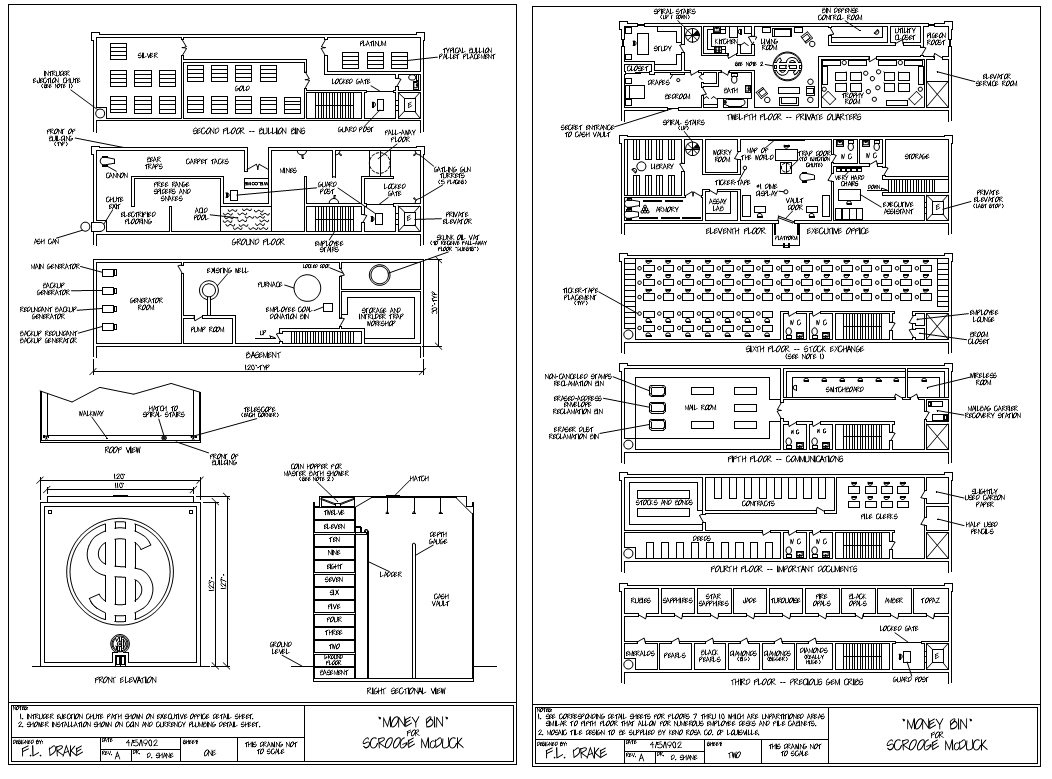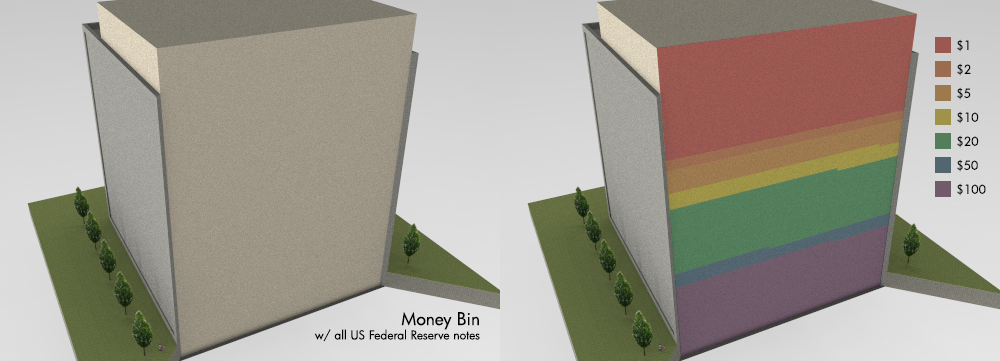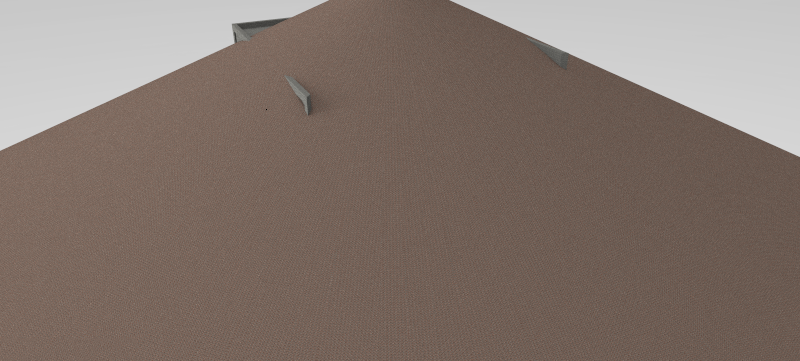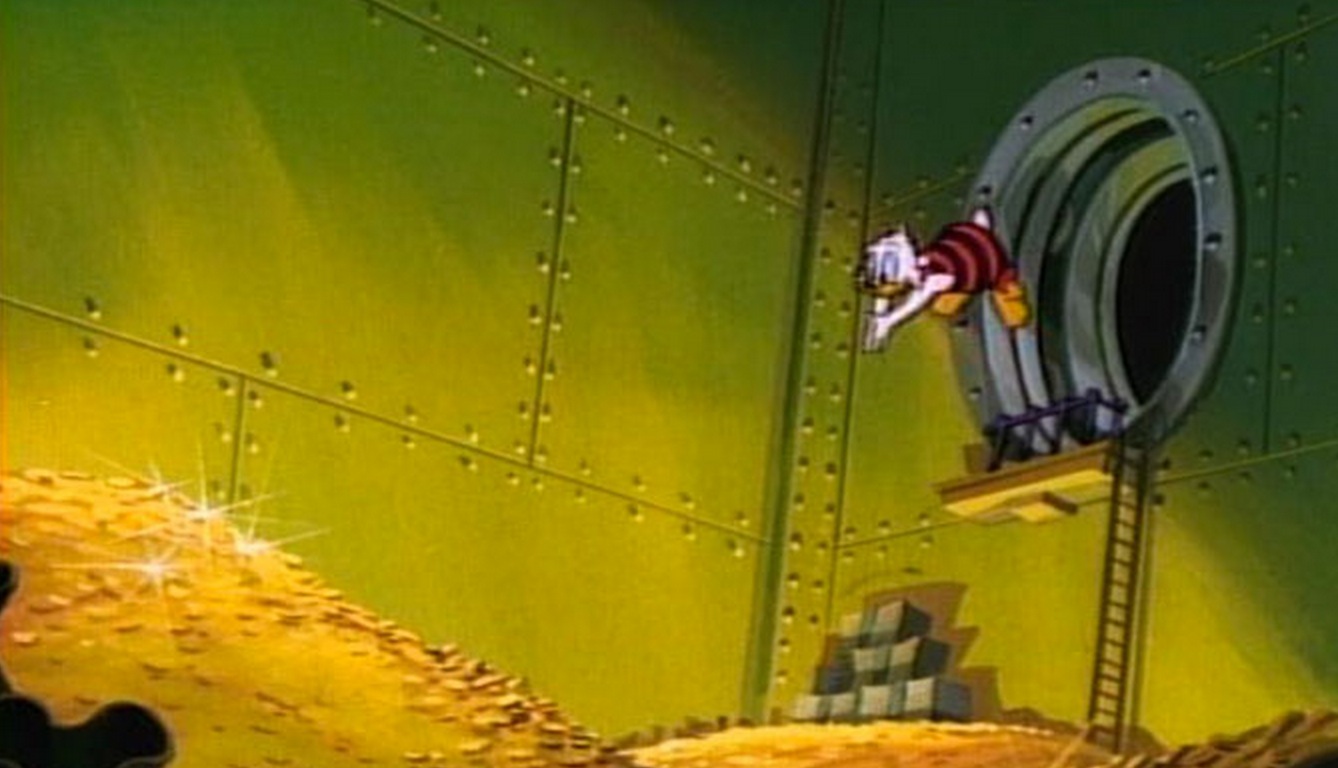Scrooge McDuck has a lot of money. He’s the richest duck in the world, consistently number one (or two) in rankings of all wealthy fictional characters. And the most conspicuous and iconic symbol of his wealth is his aptly-named “money bin”.
Unchanged in appearance since artist Carl Banks settled on its modern form in 1956, it’s one of those ridiculous symbols of childish excess that could never exist in real life. But . . . what if it did? How much real-life money would it take to fill Scrooge McDuck’s money bin?
(It’s more than all the gold in the world . . . but less than all the pennies.)
Top image: Money bin interior from the DuckTales intro, right before they go “woo-ooh” for the first time. Copyright (and source) are Disney, so I’m kinda hoping for “fair use” here.
“Burst Me Bin!”
Scrooge’s favorite descriptor for the size of his cash pile is “three cubic acres.” But a “cubic acre” would be a sixth-dimensional construct (unless you’re feeling generous and interpret acre as the side of a square acre), and Scrooge also uses numbers like “multiplujillion” and “obsquatumatillion,” so he may be prone to comedic exaggeration.
Fortunately, we have another way of calculating the volume of the bin. In 2001, “The Beagle Boys vs. the Money Bin,” featured the “original blueprints” to Scrooge’s bin. Architect and Uncle Scrooge artist Dan Shane was commissioned to draw the plans, and has helpfully posted them on his website:

Image copyright Dan Shane.
The money bin is an enormous cube, 120 feet to a side, with an extra 10 feet of basement and a slightly-raised roof. It’s not all cash, though . . . the front quarter of the bin is occupied by 13 stories of offices, a mail room, living quarters, storage for gems and bullion, etc.
Minus the offices and the shockingly-thin concrete walls, the money bin’s “swimming pool” is roughly 115.7 feet wide by 85.5 feet long, and, as for depth:
- 9o-95 feet, roughly, is the average depth of his usual money pile,
- ~105 feet to the bottom of the diving platform,
- 131.7 feet to the top, minus two small sloped segments supporting the ceiling.
“Galloping Gold Prices!”
So what would it take to fill it?
Let’s start with gold. According to Thomson Reuters GFMS, in 2013 there was 171,300 metric tons of gold in the world (not including gold still in the ground). If all that gold was melted into a single cube, it would be 68 feet (20.7 meters) to a side, nowhere near big enough to fill the bin.
But Scrooge’s bin is filled with coins, and coins introduce pockets of air. Best case scenario, neatly-stacked coins increase the volume of the gold by slightly more than 27% . . . but randomly-piled coins are far worse. Rigorous experimentation has determined that piling up coins in a container adds about 80% in additional air volume.

But even as inefficiently-packed coins, all the gold in the entire world would only fill the money bin 57 feet deep, 48 feet shy of the just the diving platform. At $1176.10/oz as of this writing, our world’s $7.1 trillion dollars of gold wouldn’t even fill the money bin halfway.
“Shiverin’ Shekels!”
Silver is a different story. More abundant (by weight) and lighter (by volume) than gold, there is more than enough silver in the world to fill the money bin, even as a solid block. Good numbers are harder to come by, but David Zurbuchen makes a credible-enough case (based on old reports and subsequent mine production) that roughly 653,000 metric tons of silver exists above ground, mostly in the form of jewelry and silverware. (This was a minimum estimate.)

With that much silver, you could fill the entire money bin wall-to-wall up to 130 feet, and have a 90-foot cube of silver left over. (Coins would fill it completely, three times.) But at the current price of $15.71/oz, all that silver is only worth about $300 billion dollars . . . far, far less than the $7.1 trillion in gold that didn’t even fill it halfway.
(By the way, see that teeny tiny blue smudge on the grass, just left of the bin? That’s Scrooge, to scale. It’s a big bin, and that’s a lot of silver.)
“Monstrous Moneybags!”
While Duckburg is a fictional city and Calisota is a fictional state, both are supposedly situated in the very real United States of America. Most of the “Donald Duck Universe” is similar enough to the real world at the national level, including currencies, so it seems natural enough that Scrooge would occasionally deal in US dollars.
According to the Federal Reserve Banks, there is $1.31 trillion in US paper money currently circulating, and about $50 billion in coins. Paper money is quite thin, but a lot of that $1,310,000,000,000 is in one dollar bills, and all those singles take up a lot of extra space:

If he skipped the $1 bills, Scrooge could comfortably fill his bin with neatly-stacked rows of US currency.
But what about the coins? Outside of that rough “$50 billion” estimate, there’s very little pre-compiled information about what US coins are circulating, so we’ll have to use historical US Mint production data as a rough model for the proportions of each coin:
- 55% pennies,
- 9% nickels,
- 16% dimes, and
- 20% quarters
- 0% half dollars or dollar coins.
Plugging a few multivariable equations into Wolfram Alpha gives us 283 billion pennies, 47 billion nickels, 83 billion dimes, and 101 billion quarters!

It’s a perfect fit!
This article originally appeared on the Observation Deck.

